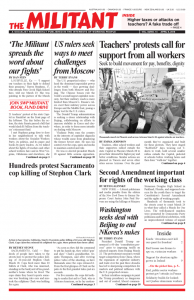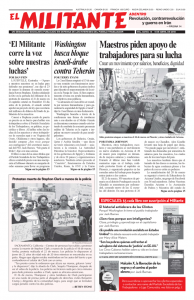President Donald Trump announced a 60-day “consultation process” prior to imposing tariffs on selected imports from Beijing March 22. The protectionist measures would target competitors from China, where the expansion of capitalist industry and trade over the past three decades has led to sharpening competition for markets and political influence with the U.S. propertied owners.
In their relentless campaign to paint the Trump presidency as dangerous and out of control, liberal commentators scream that his administration will start a “trade war” and exaggerate the extent of the protectionist threats. But U.S. and Chinese officials are using the 60-day period to meet and seek a deal on adjustments in trade.
At the same time that Washington and Beijing clash over trade, the Chinese rulers have been collaborating with the U.S. administration in tightening sanctions on North Korea. The U.S. rulers need Beijing’s backing as they press the leaders of the Democratic People’s Republic of Korea to abandon their nuclear weapons program. The North Korean government initiated talks with Washington due to be held in May.
Washington seeks greater access to China’s growing markets and seeks to defend bosses here from Chinese competition inside the U.S. The administration has threatened tariffs on up to $60 billion of imports from China. Beijing’s response was to announce tariffs would be imposed on some $3 billion of imports from the U.S., but has excluded some of the biggest items, such as soybeans, sorghum and Boeing aircraft.
Protectionist measures carried out by the Trump administration against Beijing are similar to what previous administrations have done. “We’ve brought trade cases against China at nearly twice the rate of the last administration,” boasted former President Barack Obama in 2012. His administration imposed a 35 percent tariff against Chinese tire imports.
Rulers seek to suck workers in
Republican and Democratic administrations alike use their trade policies — both protectionism and free trade — to appeal to workers to defend what they call “American interests,” which are in reality the class interests of U.S. bosses. Whatever course they pursue, the bosses seek to pit workers here against our allies, fellow toilers around the world.
Capitalist rulers elsewhere do the same. The European Union, a trading bloc of conflicting capitalist nations, imposed some 5,657 “directives” that restricted trade with nations outside the EU between 2009 and 2016.
As the largest, most powerful imperialist power, the U.S. rulers have been the greatest beneficiaries of trade pacts and conflicts for decades. But there has been intensifying competition between the exploiting class in the U.S. and China. Washington considers its domination of the Pacific and Asia to be one of its most precious spoils from its victory in World War II. And it seeks to preserve its domination there against the rising clout of Chinese capital.
The U.S. capitalist economy is overwhelmingly the world’s largest, producing 24.9 percent of total gross domestic product, compared to 15.1 percent for second-place China.
The Chinese capitalists have gained a competitive edge in the fight for some markets by the sheer size of their economy and by imposing low pay, long hours and dangerous conditions on the millions of toilers drawn into China’s expanding industries in recent decades.
These conditions fuel class tensions as Chinese workers look for ways to defend themselves. Some 1,000 workers at the Guangzhou Panyu Simone Handbag company struck for nine days in March to force the bosses to make back payments to their social insurance funds. Protests and strike actions are reported almost daily by the China Labour Bulletin.
Beijing presses North Korea
As Washington looks toward face-to-face talks between Donald Trump and North Korean leader Kim Jong Un, it also seeks to advance ties with its allies across the Pacific, including the rulers in Japan and South Korea. Trade disputes among these allies take place at the same time. The U.S. government has been pressing Seoul to open South Korean markets to more U.S.-made cars.
Washington needs Beijing to help deepen economic pressure on Pyongyang. China accounts for 90 percent of the DPRK’s trade. But that fell to a four-year low in January, as the Chinese rulers implement the U.N.’s trade sanctions. Workers in North Korea now face factory closures, job losses and rising prices. Some parts of the country have as little as three hours of electricity a day.
While Beijing has increased its pressure, the rulers there don’t want to provoke a collapse of the North and the instability that would provoke. Beijing has growing economic ties with South Korea and Japan. Japanese bosses have started collaborating with Beijing in its “Belt and Road” projects aimed at strengthening Chinese trade routes and influence across Asia, Africa and Europe. Tokyo and Seoul, which don’t have nuclear weapons, have long pressed for an end to the DPRK’s efforts to develop them.
Most importantly, Beijing wants conditions that allow it to continue to expand its own economic and military reach.
Washington, with Moscow’s complicity, seized south Korea at the end of the second imperialist world war, trampling on the Korean people’s national sovereignty. The U.S. rulers crushed a popular rebellion there, imposing the Syngman Rhee dictatorship. Workers and farmers in the north carried through a popular revolution, establishing the DPRK.
Washington waged a murderous war against the North from 1950 to 1953, leveling towns and cities, as well as in many parts of the South. To this day, the U.S. rulers have refused to sign a peace treaty with North Korea. Washington continues to station 28,500 troops in South Korea and its Pacific fleet submarines are armed with nuclear missiles.

